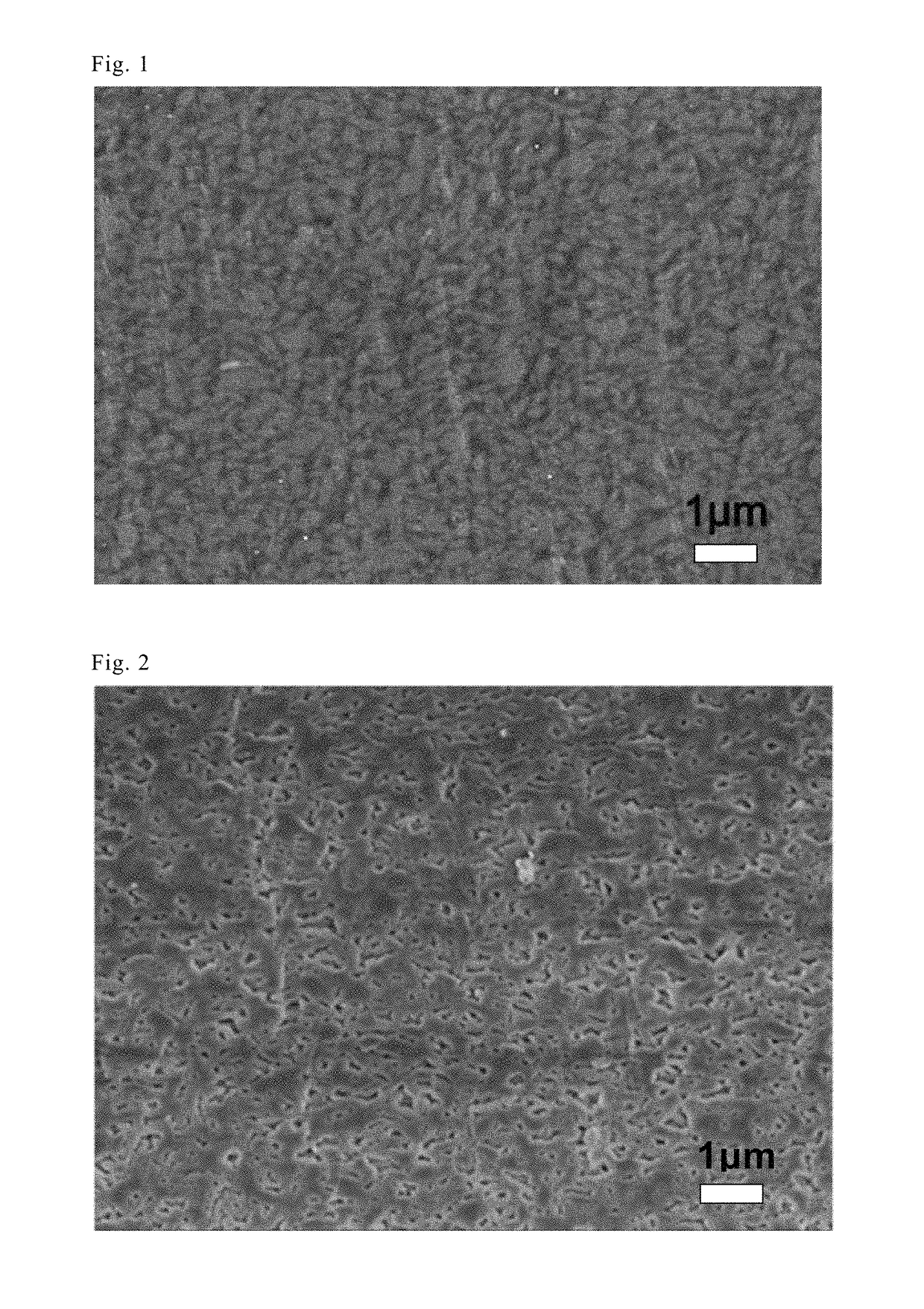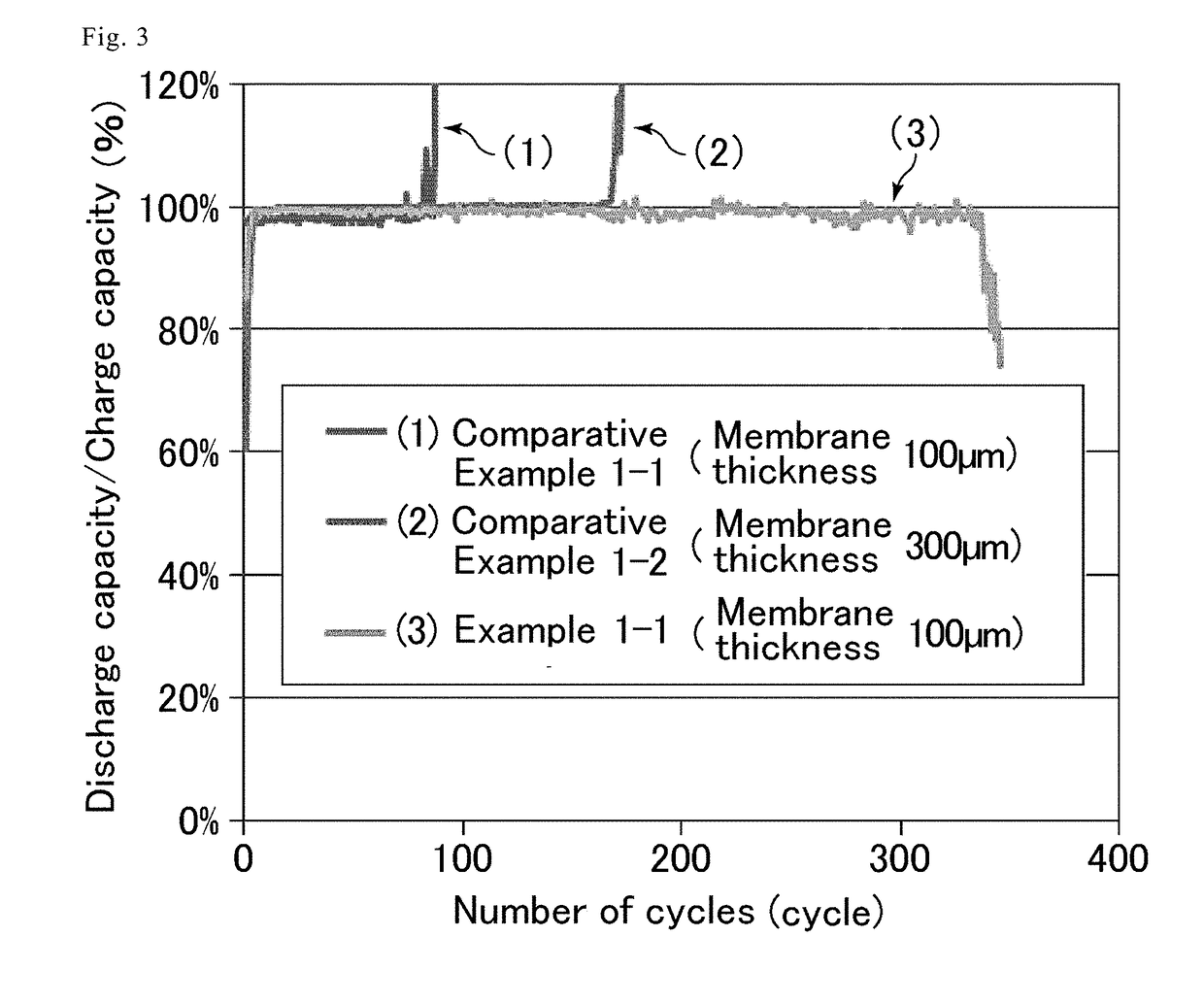Anion conducting membrane
a technology of conducting membrane and conducting material, applied in the direction of non-metal conductors, cell components, sustainable manufacturing/processing, etc., can solve the problems of failure of cell charging and discharging
- Summary
- Abstract
- Description
- Claims
- Application Information
AI Technical Summary
Benefits of technology
Problems solved by technology
Method used
Image
Examples
preparation example 1
[0259]A flask equipped with a dropping funnel, a stirrer, a nitrogen inlet tube, a thermometer, and a reflux condenser was charged with 64 parts by mass of deionized water. Separately, in the dropping funnel, a pre-emulsion was prepared from 26 parts by mass of deionized water, 4 parts by mass of a 10% aqueous solution of sodium dodecylbenzenesulfonate, 1.5 parts by mass of 1,6-hexanediol dimethacrylate, 46.5 parts by mass of methyl methacrylate, 50 parts by mass of dodecyl methacrylate, and 2 parts by mass of acrylic acid. Next, a 6.5-part by mass portion of the resulting pre-emulsion was added to the flask, the contents were heated to 80° C. under stirring while nitrogen gas was gently blown into the flask, and 2 parts by mass of a 5% aqueous solution of ammonium persulfate was added to initiate polymerization. Subsequently, the rest of the resulting pre-emulsion (123.5 parts by mass), 6 parts by mass of a 5% aqueous solution of ammonium persulfate, and 6 parts by mass of a 2.5% a...
preparation example 2
[0260]A flask equipped with a dropping funnel, a stirrer, a nitrogen inlet tube, a thermometer, and a reflux condenser was charged with 64 parts by mass of deionized water. Separately, in the dropping funnel, a pre-emulsion was prepared from 26 parts by mass of deionized water, 4 parts by mass of a 10% aqueous solution of sodium dodecylbenzenesulfonate, 54 parts by mass of methyl methacrylate, 44 parts by mass of dodecyl methacrylate, and 2 parts by mass of acrylic acid. Next, a 6.5-part by mass portion of the resulting pre-emulsion was added to the flask, the contents were heated to 80° C. under stirring while nitrogen gas was gently blown into the flask, and 2 parts by mass of a 5% aqueous solution of ammonium persulfate was added to initiate polymerization. Subsequently, the rest of the resulting pre-emulsion (123.5 parts by mass), 6 parts by mass of a 5% aqueous solution of ammonium persulfate, and 6 parts by mass of a 2.5% aqueous solution of sodium hydrogen sulfite were unifor...
preparation example 3
[0261]A flask equipped with a dropping funnel, a stirrer, a nitrogen inlet tube, a thermometer, and a reflux condenser was charged with 63 parts by mass of deionized water. Separately, in the dropping funnel, a pre-emulsion was prepared from 21 parts by mass of deionized water, 10 parts by mass of a 25% aqueous solution of HITENOL LA-10, 1.5 parts by mass of 1,6-hexanediol dimethacrylate, 21 parts by mass of methyl methacrylate, 76 parts by mass of 2-ethylhexyl methacrylate, and 1.5 parts by mass of acrylic acid. Next, a 6.5-part by mass portion of the resulting pre-emulsion was added to the flask, the contents were heated to 80° C. under stirring while nitrogen gas was gently blown into the flask, and 2 parts by mass of a 5% aqueous solution of ammonium persulfate was added to initiate polymerization. Subsequently, the rest of the resulting pre-emulsion (124.5 parts by mass), 6 parts by mass of a 5% aqueous solution of ammonium persulfate, and 6 parts by mass of a 2.5% aqueous solu...
PUM
| Property | Measurement | Unit |
|---|---|---|
| Fraction | aaaaa | aaaaa |
| Percent by mass | aaaaa | aaaaa |
| Percent by mass | aaaaa | aaaaa |
Abstract
Description
Claims
Application Information
 Login to View More
Login to View More - R&D
- Intellectual Property
- Life Sciences
- Materials
- Tech Scout
- Unparalleled Data Quality
- Higher Quality Content
- 60% Fewer Hallucinations
Browse by: Latest US Patents, China's latest patents, Technical Efficacy Thesaurus, Application Domain, Technology Topic, Popular Technical Reports.
© 2025 PatSnap. All rights reserved.Legal|Privacy policy|Modern Slavery Act Transparency Statement|Sitemap|About US| Contact US: help@patsnap.com



